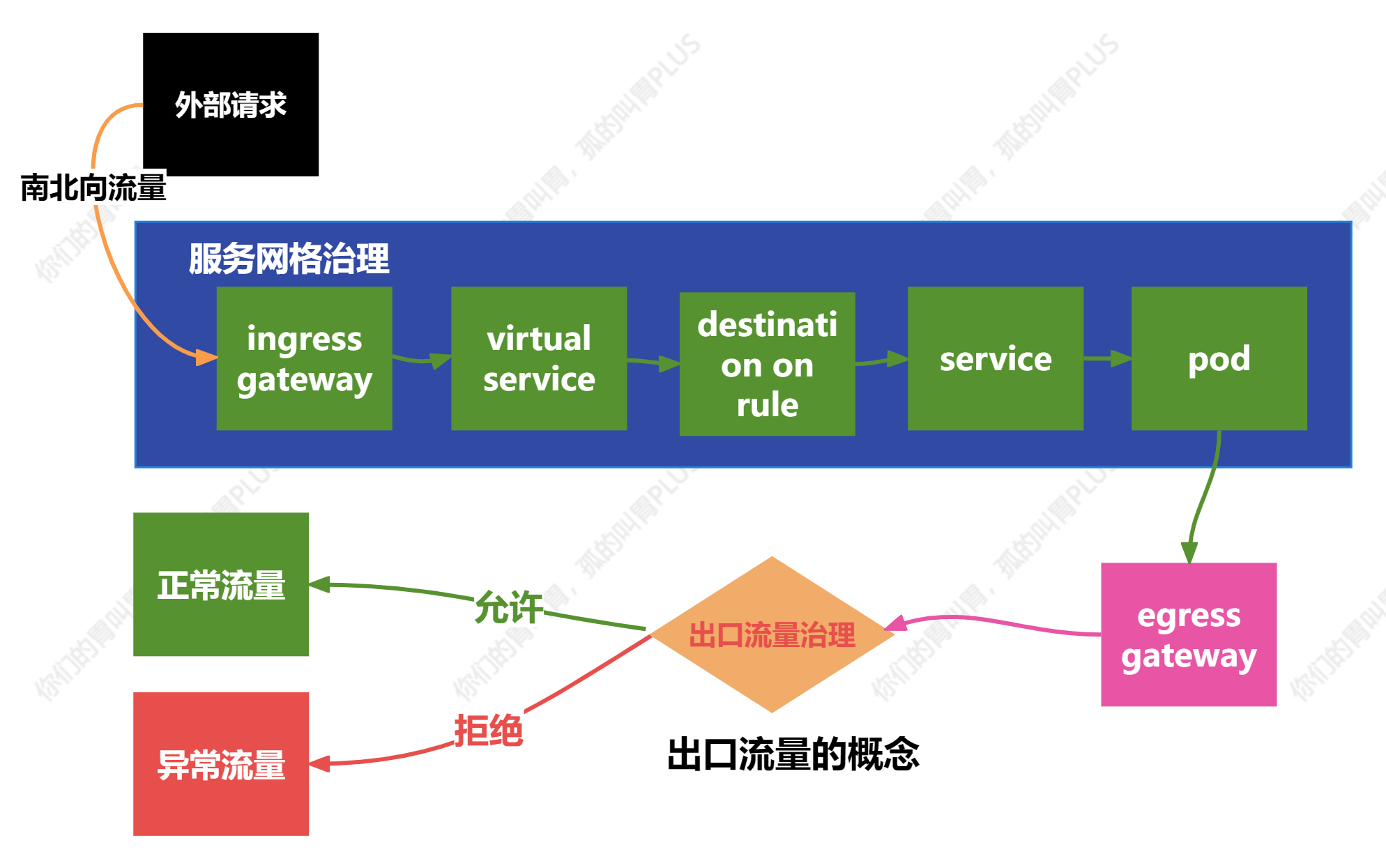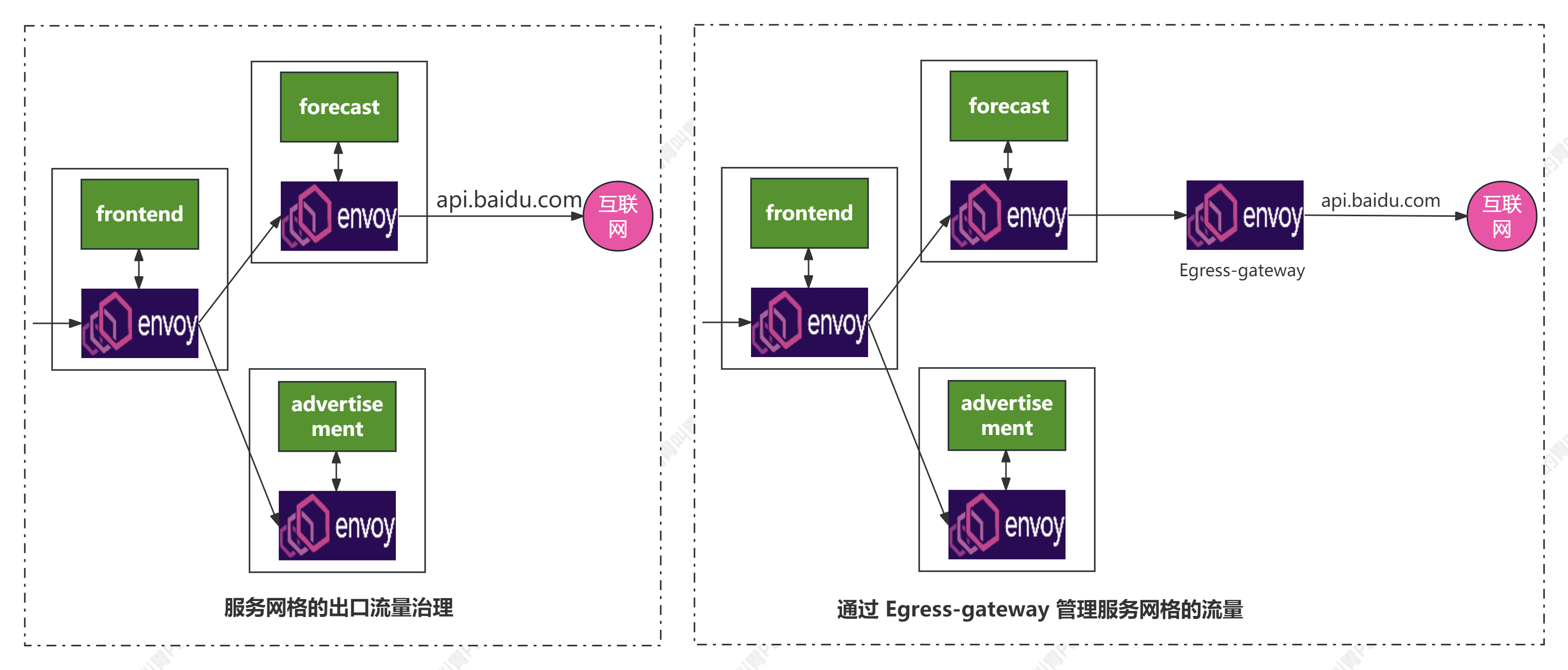Istio从入门到精通—— 流量治理的原理 —— 入口流量、出口流量
流量治理的原理 —— 入口流量、出口流量
一、入口流量的概念
从服务网格的定义来看,服务网格主要管理内部服务间的东西向流量。而 Istio 作为一个完整的服务网格解决方案和服务管理平台,除了通过数据面 Sidercar 管理东西向流量,还通过内置的 Ingress-gateway 提供对入口的南北向流量的管理。 关于服务网格和API网关技术的讨论一直很热烈,这里不做过多比较。从实践来看,两者在云原生场景中的配合与融合是必然趋势。特别是 Istio 从应用层流量解决方法提供了统一的入口和内部流量管理,成为两者融合的一个标准实践。
关于服务网格和API网关技术的讨论一直很热烈,这里不做过多比较。从实践来看,两者在云原生场景中的配合与融合是必然趋势。特别是 Istio 从应用层流量解决方法提供了统一的入口和内部流量管理,成为两者融合的一个标准实践。
我们从以下 3 种不同入口接入和流量管理形态,理解入口流量的概念。
1.1、传统4/7层的入口流量
LVS 和 Nginx 的主要区别在于它们工作的网络层次。LVS 工作在 4 层,主要进行简单的流量分发,而 Nginx 工作在 7 层,可以处理更复杂的应用层流量和内容。
两者各有优势,通常在实际的网络架构中可能会结合使用,以满足不同的负载均衡需求。
1.1.1、LVS(Linux Virtual Server)
https://github.com/alibaba/LVS
- 工作在网络4层(传输层),这意味着它处理的数据包是在IP协议之上的,如TCP和UDP。
- LVS主要作为分发器使用,并不产生流量。它仅仅是将客户端的请求分发到后端真实服务器,所以流量并不经过LVS本身。
- 由于LVS工作在网络4层,它可以对几乎所有应用进行负载均衡,如http、数据库、在线聊天室等。
- LVS具有抗负载能力强、对内存和CPU资源消耗低的特点。
1.1.2、NGINX
https://github.com/nginx/nginx
- Nginx是一个7层(应用层)的负载均衡器/反向代理服务器,它能够处理更多的应用层协议,如HTTP、HTTPS、SMTP等。
- 与LVS相比,Nginx更能够理解和处理应用层的流量和内容,比如对HTTP请求的URL、头部等信息进行处理。
- Nginx也可以作为反向代理,缓存静态内容,减轻后端服务器的压力。
- 由于其工作在7层,Nginx的配置性相对较高,提供了更多的灵活性和功能性。
1.2、Kubernetes 的入口流量
https://kubernetes.io/docs/concepts/services-networking/service/
https://kubernetes.io/docs/concepts/services-networking/ingress/
Service定义:https://kubernetes.io/docs/concepts/services-networking/service/#defining-a-service
Service服务类型:https://kubernetes.io/docs/concepts/services-networking/service/#publishing-services-service-types
Ingress定义:https://kubernetes.io/docs/concepts/services-networking/ingress/#what-is-ingress
Ingress类型:https://kubernetes.io/docs/concepts/services-networking/ingress/#types-of-ingress
GatewayAPI:https://kubernetes.io/docs/concepts/services-networking/gateway/
1.3、传统微服务的入口流量
SpringCloud原生:https://spring.io/projects/spring-cloud-gateway#overview
SpringCloud原生:https://docs.spring.io/spring-cloud-gateway/docs/current/reference/html/
SpringCloudAlibaba:https://spring-cloud-alibaba-group.github.io/github-pages/2021/en-us/index.html#_support_spring_cloud_gateway
This project provides a libraries for building an API Gateway on top of Spring WebFlux or Spring WebMVC. Spring Cloud Gateway aims to provide a simple, yet effective way to route to APIs and provide cross cutting concerns to them such as: security, monitoring/metrics, and resiliency.
https://github.com/alibaba/Sentinel/wiki/API-Gateway-Flow-Control
If you want to use
Sentinel Starter with Spring Cloud Gateway, you need to add
thespring-cloud-alibaba-sentinel-gatewaydependency and add
thespring-cloud-starter-gatewaydependency to let Spring Cloud Gateway AutoConfiguration class
in the module takes effect:

1.4、Istio的入口流量
Controlling ingress traffic for an Istio service mesh:
- Istio Gateways:https://istio.io/latest/docs/tasks/traffic-management/ingress/ingress-control/
- Secure Gateways:https://istio.io/latest/docs/tasks/traffic-management/ingress/secure-ingress/
- Ingress Gateway without TLS Termination:https://istio.io/latest/docs/tasks/traffic-management/ingress/ingress-sni-passthrough/
- Ingress Sidecar TLS Termination:https://istio.io/latest/docs/tasks/traffic-management/ingress/ingress-sidecar-tls-termination/
- Kubernetes Ingress:https://istio.io/latest/docs/tasks/traffic-management/ingress/kubernetes-ingress/
- Kubernetes Gateway API:https://istio.io/latest/docs/tasks/traffic-management/ingress/gateway-api/
二、出口流量的概念(相比入口流量,出口流量更加关键)

当流量从一个内部的管理域流出到外部的管理域时,其安全、治理、监控的要求也会不同,需要在边界处进行特别的控制,比如控制允许哪些内部服务访问外部服务。采用传统方式时,一般在边界上部署的防火墙基于源 IP
地址进行访问控制,云原生场景中负载 IP 地址的动态变化导致基于 IP 地址的规则基本不能维护,即使配置 IP 段解决了 IP 地址变化的问题,又会出现不同的业务共享 IP
段导致控制颗粒度不足的问题。这时基于传统网络的访问控制就不能满足要求,比较好的办法是基于应用层进行控制,而服务网格正是这种应用层管理的理想方案。







【推荐】国内首个AI IDE,深度理解中文开发场景,立即下载体验Trae
【推荐】编程新体验,更懂你的AI,立即体验豆包MarsCode编程助手
【推荐】抖音旗下AI助手豆包,你的智能百科全书,全免费不限次数
【推荐】轻量又高性能的 SSH 工具 IShell:AI 加持,快人一步
· 阿里最新开源QwQ-32B,效果媲美deepseek-r1满血版,部署成本又又又降低了!
· 开源Multi-agent AI智能体框架aevatar.ai,欢迎大家贡献代码
· Manus重磅发布:全球首款通用AI代理技术深度解析与实战指南
· 被坑几百块钱后,我竟然真的恢复了删除的微信聊天记录!
· AI技术革命,工作效率10个最佳AI工具